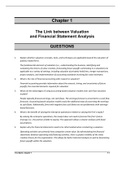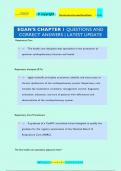Chapter 1
The Link between Valuation
and Financial Statement Analysis
QUESTIONS
1. Explain whether valuation concepts, tools, and techniques are applicable beyond the valuation of
publicly traded firms.
The fundamental elements of valuation (i.e., understanding the business, identifying and
evaluating the drivers of value creation, forecasting future payoffs culminating in a valuation) are
applicable to a variety of settings, including valuation of privately held firms, merger transactions,
project analysis, and implementation of accounting standards involving fair value estimates.
2. What is the role of financial accounting with respect to valuation?
Financial accounting provides information about the amount, timing, and uncertainty of future
payoffs; the essential elements required for valuation.
3. What are the advantages of using accounting-based valuation models over cash flow valuation
models?
People typically forecast earnings, not cash flows. The earnings forecast is converted to a cash flow
forecasts. Accounting based valuation models avoid the additional step of converting the earnings
to cash flows. Additionally, firms with negative free cash flows are not problematic with earnings-
based forecasts.
4. What is the benefit of valuing the enterprise operations relative to valuing the firm’s equity?
By valuing the enterprise operations, the analyst does not need to forecast the firm’s future
leverage (i.e., the portion of debt to equity). This approach allows a cleaner analysis with fewer
assumptions.
5. Explain why the financial statements need to be reformulated when conducting a valuation.
Operating activities are primarily how companies create value. By reformulating the financial
statements between operating and financing activities, there is greater visibility of the value
creation drivers for the organization. This allows for better historical analysis as well as forecasting
future payoffs within the valuation.
Test Bank, Chapter 1 1-1
,6. How do revenues and expenses differ from the resulting cash flows?
The difference between revenues and expenses from the related cash flows is the accruals. The
accruals represent the timing differences between the recognition of the revenue and expense and
the cash flows. Additionally, the accruals include accounting estimates (e.g., bad debt expense).
For example, the change in accounts receivable including the allowance for bad debts explains the
difference between sale revenues and the resulting cash flows.
7. What is a limitation of using a company’s Form 10-K, section 1A, Risk Factors, as the source of the
material risks facing the company?
The Risk Factors section of the Form 10-K provides an accurate list of potential risks and
uncertainties for the company. However, the number of risk factors disclosed can be extensive and
it effectively weighs all risks equally. The risks need to be evaluated by their impact and relevance
in impacting the firm’s future financial position and performance.
8. How does Understanding the Business and the Business Environment provide a more accurate
valuation.
Without a solid understanding of the business and its environment, the financial analysis and,
subsequent forecasts, can be misleading resulting in poor estimates of expected payoffs. Financial
analysis requires a strong understanding of the business to correctly evaluate the firm’s financial
position and performance. Additionally, having a strong understanding of the business and its
environment allows for better forecasts that reflect the firm’s economic reality. Financial analysis
and forecasting resulting in better estimates of future payoffs results in a more accurate valuation.
9. Identify the fundamentals in Understanding the Business and the Business Environment.
The essential elements to understanding the business are (1) knowing the company’s primary
operating activity(ies), (2) the company’s customers, (3) and suppliers, and (4) identifying the
company’s material risk and uncertainties.
10. How does understanding a company’s life cycle stage impact forecasts of operating asset turnover
and profit margin.
The expectation of operating asset turnover and profit margin change as a company moves
through the various life cycle stages. In the Introduction phase, operating asset turnovers and
profit margins are generally lower than in growth or mature phase. As the company moves to
shake-out or decline, profit margins will decrease as will operating asset turnover. Having an
understanding of the firm’s life cycle stage will facilitate more accurate forecasts.
© Cambridge Business Publishers, 2021
1-2 Valuation Using Financial Statements, 2nd Edition
, EXERCISES
11. Convert the fundamental accounting equation Assets = Liabilities + Equity to the reformulated Net
operating assets (NOA) = Net financial liabilities (NFL) + Common shareholders’ equity (CSE).
(1) Assets = Liabilities + Equity
(2) (Operating assets + Financial Assets) = (Operating Liabilities + Financial liabilities) + (Preferred
stock + Common stock + Retained Earnings)
(3) (Operating assets – Operating liabilities) = (Financial liabilities – Financial assets + Preferred
stock) + (Common stock + Retained Earnings)
(4) NOA = NFL + CSE
© Cambridge Business Publishers, 2021
Test Bank, Chapter 1 1-3
, CONTINUING EXAMPLES
Throughout the text, we will analyze General Mills (GIS) and move toward valuation of the
company. Within the test bank materials, we will repeat the process illustrated within the
text by following FedEx (FDX) and United Parcel Service (UPS) which are close
competitors as well as Procter & Gamble (PG) and Kimberly-Clark (KMB). This will
facilitate the application of the valuation steps to similar real-life firms.
12. Use Dickinson’s (2011) cash flow matrix to evaluate the life cycle stage classification for FedEx
(FDX).
Based on the fiscal year 2019 Consolidated Statement of Cash Flows, FedEx has positive operating
cash flows, negative investing cash flow and negative financing cash flow which indicates that
FedEx is in its Mature stage of its life cycle.
© Cambridge Business Publishers, 2021
1-4 Valuation Using Financial Statements, 2nd Edition





